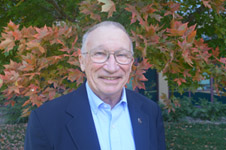Natural Resources, School of
Document Type
Article
Date of this Version
6-2014
Citation
OUTCROP: Newsletter of the Rocky Mountain Association of Geologists (June 2014) 63(6): 14-16.
Abstract
I first walked through the doors of Morrill Hall on the main or City Campus of the University of Nebraska on a day late in August of 1962 and thought that I had entered paleontology heaven. Morrill Hall then housed the University of Nebraska State Museum (UNSM). most of the Geology Department, and some other parts of university units. I was a new graduate student hoping to pursue research in invertebrate paleontology in the Department of Geology and was on my way to see the department chairman for the first time. When I entered the building I walked through a vestibule and found myself headed directly into one huge gallery of fossil elephants. Elephant Hall. Wow. what a sightl Even today. more than 50 years later the hall is extraordinary with its fully mounted mastodons and mammoths and its fine displays of all things proboscidean. These were not invertebrate fossils, but Elephant Hall. They were wonderful.
The history of the museum started in 1871 with the establishment of a "Cabinet" for natural history specimens by the University Board of Regents. The present museum building. Morrill Hall. was dedicated in 1927 and has undergone many improvements since then. UNSM has eight informal divisions: Anthropology, Botany, Entomology, Invertebrate Paleontology, Parasitology, Vertebrate Paleontology, Zoology, and Informal Science Education. There are separate Geology collections of minerals, rocks, and meteorites. UNSM is fully accredited.
Included in
Geology Commons, Geomorphology Commons, Hydrology Commons, Museum Studies Commons, Science and Mathematics Education Commons, Stratigraphy Commons


